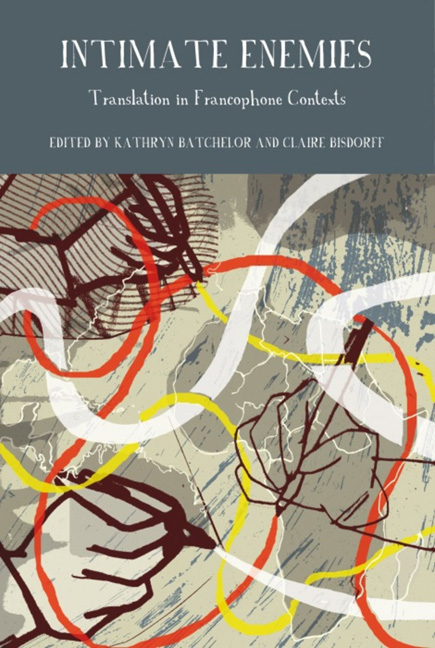Book contents
- Frontmatter
- Contents
- Illustration
- Acknowledgements
- Introduction: Translation – Formidable Enemy or Needed Friend?
- The Translation Market: Publishing and Distribution
- Writing and Translating in Practice
- Intimate Enemies: A Conversation between an Author and her Translator
- Translation: Spreading the Wings of Literature
- Translation – A Listening Art
- Ananda Devi as Writer and Translator: In interview with Julia Waters
- The Négraille's Testament: Translating Black-Label
- Translating Heterophony in Olive Senior's Stories
- Translation Challenges and New Avenues in Postcolonial Translation Theory
- Notes on Contributors
- Index
Intimate Enemies: A Conversation between an Author and her Translator
from Writing and Translating in Practice
- Frontmatter
- Contents
- Illustration
- Acknowledgements
- Introduction: Translation – Formidable Enemy or Needed Friend?
- The Translation Market: Publishing and Distribution
- Writing and Translating in Practice
- Intimate Enemies: A Conversation between an Author and her Translator
- Translation: Spreading the Wings of Literature
- Translation – A Listening Art
- Ananda Devi as Writer and Translator: In interview with Julia Waters
- The Négraille's Testament: Translating Black-Label
- Translating Heterophony in Olive Senior's Stories
- Translation Challenges and New Avenues in Postcolonial Translation Theory
- Notes on Contributors
- Index
Summary
Richard Philcox: I began my career as a technical translator with Kodak– Pathé, the French affiliate of Eastman Kodak in Paris. The task of a technical translator was to translate into English the company's annual, technical and financial reports, instruction leaflets and general correspondence that had to be sent back to the US headquarters in Rochester. It was when your first novel Heremakhonon was published in 1976 that I launched into literary translation. I was approached by Three Continents Press in Washington, DC for an English translation and used my time in the office to work on it. At the time I hadn't thought much about the theory of translation and adapted much of the rules of technical translation to a literary work, i.e., absolute clarity, no ambiguity, reduction to short sentences and very little left to the imagination. I see now that none of this corresponded to a novel such as Heremakhonon, which narrated childhood memories and complex events in Africa.
Maryse Condé: When I wrote the first version of Heremakhonon I was living in Guinea and involved in the theatre festival focused on the griots directed by my first husband, Mamadou Condé. The griots are called maîtres de la parole. For them, prose, poetry and music should be blended to produce a complex form of expression. A griot is therefore both a poet and a musician. In the villages, theatre performances last the entire night since there is no climax, but a sequence of events, all of them important in their own way.
Richard Philcox: Your bestseller Segu (1987) was given to Barbara Bray to translate who was more familiar with Marguerite Duras than with the customs of Mali. The translation needed serious editing before we could give our approval. It wasn't until after La Vie scélérate [Tree of Life] (1992), translated by Victoria Reiter, that I became your accredited translator. It was then I began to reflect on and research the theory of translation and elaborate a personal concept based on equivalent effect and domestication of the foreign text into my own culture. My translation of Crossing the Mangrove (1995) was very much influenced by Virginia Woolf's To the Lighthouse (1927) since the interior monologue corresponded exactly to the twenty monologues in the novel.
- Type
- Chapter
- Information
- Intimate EnemiesTranslation in Francophone Contexts, pp. 89 - 97Publisher: Liverpool University PressPrint publication year: 2013

